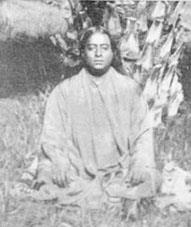
Kriya Yoga, “the airplane route to God,” yet still relatively unknown today, comes to us with an incredible past and history. Its light has been shining on the firmament of the ages, as a redeemer of countless souls. Its history is filled with the most illustrious saints and masters. And all of us who are part of this sacred Kriya tradition are bathing in their silent blessings. Kriya Yogis are linked to a truly fascinating legacy.
When we talk about Kriya Yoga, we mostly think of Yogananda and his line of Kriya-Gurus: Mahavatar Babaji, Lahiri Mahasaya, and Sri Yukteswar. However, what we are seeing is like a chain of which we have picked only a little bit out of the ocean, and that is all we can see. The chain itself goes down under the ocean for who knows how far!
Kriya Yoga, it is said, reaches back to the very beginnings of yogic life. Why? The reason is that Kriya, the highest technique of Raja Yoga, draws on universal, central facts of human nature.
“The law of Kriya Yoga is eternal. It is true like mathematics; like the simple rules of addition and subtraction, the law of Kriya can never be destroyed. Burn to ashes all the books on mathematics, the logically-minded will always rediscover such truths; destroy all the sacred books on yoga, its fundamental laws will come out whenever there appears a true yogi who comprises within himself pure devotion and consequently pure knowledge.”
(Sri Ananda Mohan Lahiri, a grandson of Lahiri Mahasaya, quoted in Autobiography of a Yogi)
Kriya of course has not always been called “Kriya Yoga.” Babaji renamed it “Kriya Yoga” for this age. Yogananda writes: “Kriya Yoga is described in certain scriptures as Kabali Pranayama” (or Kevali Pranayama, or Kevala Pranayama, according to dialect. “Kevala” means “alone”, referring to the Self). “Kabali Pranayama was considered to be the greatest of all techniques in controlling prana (life force).” It scientifically leads the devotee to breathlessness. “Breathlessness is deathlessness.” The result is Cosmic Bliss.
“Kriya is an ancient science,” Yogananda writes. Mahavatar Babaji rediscovered and clarified the technique after it had been lost in the Dark Ages. Babaji revealed to Lahiri Mahasaya:
“The Kriya Yoga which I am giving to the world through you in this nineteenth century is a revival of the same science which Krishna gave, millenniums ago, to Arjuna, and which was later known to Patanjali, and to Christ, St. John, St. Paul, and other disciples.”
Let’s look at some of these world-famous Kriyaban-saints, since at least we know about these parts of the Kriya-chain!
~~~
Bhagavan Krishna
Around 700BC (plus incarnations much earlier)
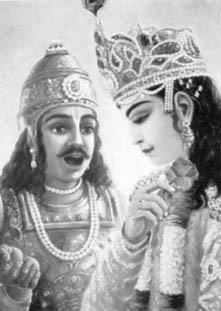
Sri Krishna, an avatar, taught Kriya Yoga, as we’ve just heard. Thus Arjuna and his heroic Pandava-brothers received the Kriya technique from him.
Krishna’s life as a Kriya-teacher alone would suffice to make our Kriya history unforgettable. But again we are seeing only the surface of a long invisible chain: Krishna had already taught Kriya in his former lifetimes. “In an earlier incarnation” he initiated Vivasvat into Kriya Yoga, as Yogananda writes in his Autobiography of a Yogi, explaining a certain passage in the Bhagavad Gita. Vivasvat in turn initiated Manu (his son), India’s great law-giver. Manu later initiated his own son Ikshwaku.
For Westerners, these names don’t mean very much. For Hindus, however, they do. It is as if we were told in the West, “Krishna gave Kriya to Noah.” Manu in Hinduism is considered the progenitor of humankind, who gave laws and religious rules for Hindu life. Ikshvaku is considered to have been the very first king in ancient India (and founder of the Sun Dynasty). We are talking eons ago, much longer than our Western history is dealing with.
For those interested, here is the particular passage of the Bhagavad Gita, in which Krishna reveals his role in the ancient history of Kriya Yoga:
“The exalted Lord said to Arjuna: “I gave this imperishable yoga to Vivasvat. Vivasvat passed on the knowledge to Manu; Manu in turn gave it to Iksvaku. (4:1)
Handed down in this way in orderly succession, the Rajarishis (royal rishis) knew it. But, Arjuna, by the long passing of time, this yoga was lost sight on earth.(4:2)
I have this day informed you about that same ancient yoga (Kriya Yoga), because you are my devotee and friend.” (4:3)
Arjuna then asks how this can be possible, since Vivasvat lived long, long before Krishna.
Krishna replies: “Many births both you and I have passed through. I can remember them all, but you cannot.” (4:5)
In short: Krishna refers to the incredible antiquity of Kriya Yoga, and to the fact that he has been around forever, in one form or another, to teach and revive it.
Kriya was taught again and again, but then was also always lost, with the ebb and flow of the Yugas. The history of Kriya Yoga is a long record of great yogis who brought this science back again and again to its central focus, with Krishna as the charioteer of it all.
In this Yuga cycle too, Kriya Yoga was guarded by “royal rishis” until the coming of the materialistic ages. Then, due to priestly secrecy and man’s indifference, the sacred knowledge gradually became inaccessible. And once again Krishna, in the form of Mahavatar Babaji, revived it, in a most spectacular manner in a golden palace. A spiritual renaissance was set into motion for this age:
“Kriya Yoga will encircle the globe, and aid in establishing that brotherhood of man which results from direct perception of the One Father.”
~~~
Elijah
Around 850 BC
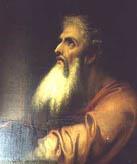
Elijah (Elias) is described as the loftiest and most wonderful prophet of the Old Testament. Elijah was the Master of Elisha (Eliseus), who, according to Yogananda, was later reborn as Jesus Christ.
Elijah (and therefore Elisha) practiced Kriya or a very similar technique (see Autobiography of a Yogi). Elijah, like Kabir and Jesus, was able through Kriya Yoga to cause his body to dematerialize at will. In death he “simply” ascended in “a chariot of fire.” Yogananda explains: “Certain yogis, like Elijah or Kabir, converted their bodies into astral currents and merged them in the Cosmic Light, without going through the ordinary phenomena of death.” Kriya Yoga was their “trick”!
At any rate, unknown to most people, we have Kriya Yoga prominently represented also in the Old Testament. Jews could therefore be inspired to practice Kriya too.
~~~
Patanjali
200BC – nobody knows for sure
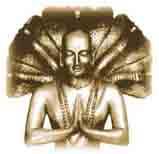
Patanjali was one of the ancient avatars, and is known today as the “Father of Yoga.” He was the great exponent of Raja Yoga, and taught ashtanga yoga (“eight- limbed” yoga) in his famous Yoga Sutras. Patanjali’s teachings are central to yoga, and could never be thought away from yogic history.
And well: Patanjali too was a Kriya Yogi, as Babaji states in the Autobiography of a Yogi.
Most interestingly, Georg Feuerstein (one of the foremost yoga scholars today), in his acclaimed Encyclopedic Dictionary of Yoga, writes: “Even though Patanjali’s Yoga has achieved fame for its eightfold path, it is likely that this particular systematization was merely cited by Patanjali, and that his own contribution to Yoga was Kriya Yoga.”
~~~
Shankaracharya
Most say around 700AD, others claim 500BC
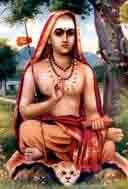
Shankaracharya (Shankara), foremost exponent of the Advaita (non dual) Vedanta philosophy, was the reformer of the ancient Swami order in India. All the ten Swami orders go back to him as the first, “Adi” Shankaracharya. All swamis thus trace their spiritual lineage to one common guru, Shankara. He is certainly one of the most pivotal figures in yogic tradition.
Shankaracharya is widely recognized as a philosophical genius, a saint of the highest order, an incredible astrologer and writer. He established the four main “Shankaracharya Maths”, where the four main Indian spiritual authorities reside until today, in the four corners of India.
Mahavatar Babaji states in the Autobiography of a Yogi that it was he himself who initiated Shankara into Kriya Yoga. Yogananda told the fascinating story how Shankaracharya came to accept Kriya initiation from Babaji.
Here is the story, as retold by Swai Kriyananda in Conversations With Yogananda”:
The Master told this little-known story of the meeting between Swami Shankaracharya and Babaji, whom Shankaracharya eventually accepted as his guru.
“Babaji was living in a home in Benares, when Shankaracharya visited that city. Shankara was at that time a famous astrologer. Babaji’s manservant went therefore to see him. He received from Shankara the shocking news that, that very night, it was his destiny to die! In fear and trembling, on his return, he approached Babaji with the news.
“‘Go back,’ said Babaji, ‘and say to him that you will not die tonight.’
“The servant carried this reply back to Swami Shankara, who affirmed, ‘This karma is so fixed that, should you survive it, I shall go to your master and ask him to accept me as his disciple.’
“That night, a terrible thunderstorm lashed the city. Lightning struck everywhere. It felled trees all around the house where Babaji lived. The great master stretched himself out over the servant’s body, to protect him. When morning came, the servant was still alive. He then went and presented himself to Shankara. The Swami was amazed. Realizing that he had encountered a power much greater than his own, he went to Babaji and took initiation into Kriya Yoga.”
~~~
Jesus Christ
About 0 AD
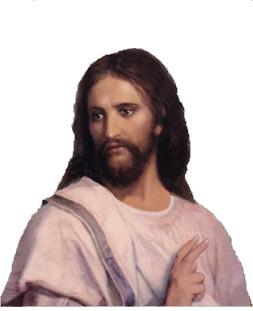
Jesus lived in India during his “lost 18 years,” and practiced and taught Kriya Yoga. His disciples, the apostles, too, were Kriya Yogis, as Babaji states. Even St. Paul, who didn’t know Jesus personally, received Kriya- either in vision from Jesus, or from his direct disciples, in Indian fashion.
Through Kriya Yoga, St. John could share his cosmic experiences: “In the beginning was the Word.” In Revelation he talks about the mystery of “the seven stars” and the “seven churches.”
Through Kriya Yoga, St. Paul could declare: “I die daily!”
Kriya Yoga might daringly be described as the essence of Christianity, and Kriya Yogis as the truest Christians.
Jesus still today works hand in hand with Babaji, as Yogananda states. Kriya Yoga through them will finally spread all over the globe. Kriya Yogis today are spiritual forerunners, pioneers, like the early Christians. May they hold the light of Kriya high.
~~~
Kabir
1440 – 1518
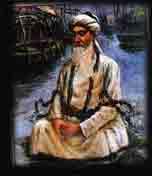
Kabir too was a great Kriya Master, as we read in the Autobiography of a Yogi, and received Kriya initiation from Mahavatar Babaji.
Kabir was called the “Creedless Master,” who scoffed at the ancient rivalry between Hindus and Muslims. He happily was the guru of both Hindus and Mohammedans.
The final act of Kabir’s life exemplifies beautifully his non-sectarian teachings: At his death the disciples were fighting if his body should be buried in Muslim fashion, or burned in Hindu fashion. Kabir rose from death, telling them: “Half of my remains shall be buried by the Moslem rites, and let the other half be cremated with a Hindu sacrament.” He then vanished. When the disciples opened the coffin which had contained his body, nothing was found but a dazzling array of gold-colored champak flowers. Half of these were obediently buried by the Moslems, who revere his shrine to this day. The other half was used for Hindu rites.
If Kabir should return today, again as a Kriya saint, he would probably work hard to dissolve the childish controversies of various Kriya lines, which teach: “Our Kriya tradition is the true, highest, and original Kriya.” He might answer (in Kabir’s poetic way): “All those who bathe in the Kriya-Ganga are my children.” And, “It is the flowering that counts, not the flower!”
~~~
Trailanga Swami
1601-1881
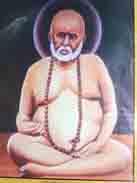
Trailanga Swami is described by his devotees as “the greatest of the known Kriya Yogis.” He was a rebel, a public problem child, ever naked, enormously fat, performing publicly all kinds of stunning miracles. He was a good friend of Lahiri Mahasaya. Trailanga’s guru was called Bhagiratananda Saraswati, who initiated him into Kriya Yoga. Trailanga Swami came to be know as Sachal Vishwanath (moving Lord Vishwanath or Shiva).
Here’s a little story, typical for his tumultuous personality: Ramakrishna, the great master, went to Varanasi to meet Trailanga Swami in 1869. Trailanga took his urine and sprinkled it on the idol of the Goddess whom Ramakrishna worshipped, and asked him: “What is the difference between my urine and Ganga water?” Ramakrishna, instead of being provoked or offended, saw that Trailanga’s words were his true inner realization. He therefore said about Trailanga: “I saw that Universal Lord Himself was using his body as a vehicle for his Manifestation.”
~~~
Mahatma Gandhi
1869-1948
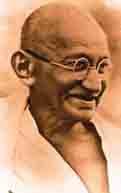
The Mahatma (“great soul”) also became a Kriya Yogi, through Yogananda. He thus recognized the greatness of what Yogananda taught, and is now part of the Kriya tradition.
“Other prophets,” as Yogananda writes in his Autobiography of a Yogi, also practiced Kriya, and are part of the chain of the Kriya history. India’s ancient King Janaka (guru of Sukdeva, who was the son of Vyasa, the author of the Mahabharata), whom Krishna mentions in the Bhagavad Gita, was one of them, as Yogananda wrote.
Of course in this recent period we would have to add to the Kriya history the exalted disciples of Babaji, Lahiri Mahasaya, Sri Yukteswar, and Yogananda. Swami Kebalananda is just one luminous example, who said:
“I myself consider Kriya the most effective device of salvation through self-effort ever to be evolved in man’s search for the Infinite.”
And as Kriya Yoga has an incredible past, with Jesus, Krishna, Patanjali, Shankaracharya in its midst, so will its future be glorious. The Kriya-chain is energetic, and keeps growing. Yogananda writes in his Autobiography of a Yogi:
“The blessed role of Kriya Yoga has hardly more than just begun!”
Enough now of history and theory. Lahiri Mahasaya counsels us:
“Continue ceaselessly on your path to liberation through Kriya, whose power lies in practice.”
So let’s get these currents going, going, going, to finally exclaim: “JAI KRIYA YOGA!”
